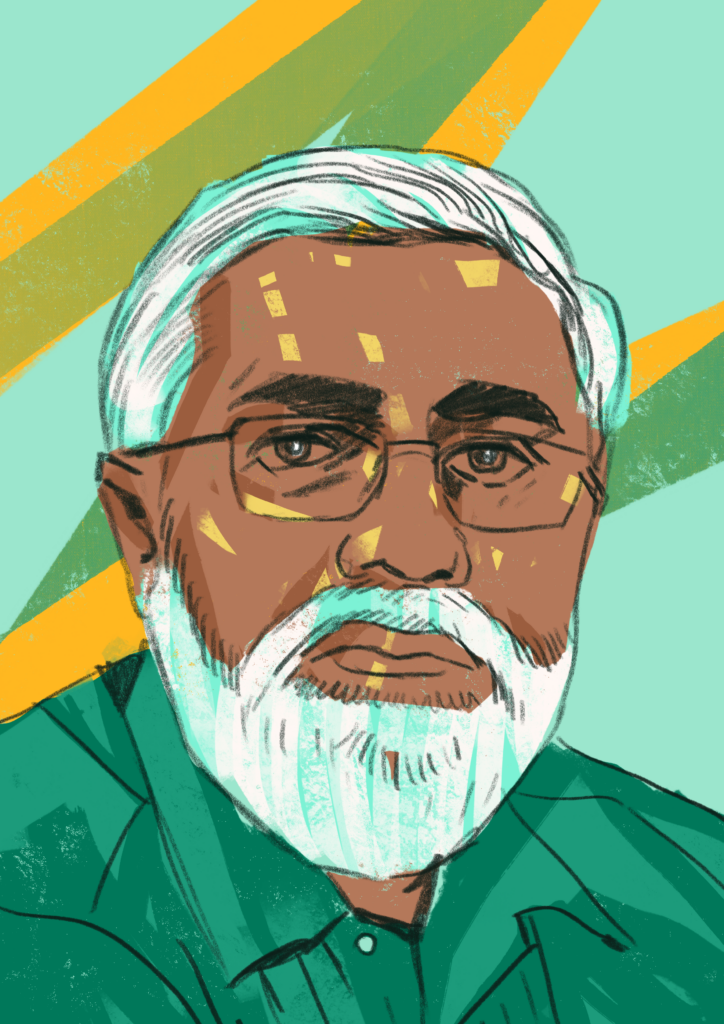Impact Makers: Rajesh Shah
Championing community-driven climate resilience through the Great Green Wall of Gujarat
By Climate Champions | November 20, 2024
 NAME
NAME
Rajesh Shah
TITLE
Managing Trustee, VIKAS Centre for Development
LOCATION
Ahmedabad, India
ABOUT
Rajesh Shah is the Managing Trustee at VIKAS Centre for Development, where he leads the Great Green Wall of Gujarat initiative. This project integrates climate action with socio-economic upliftment, addressing urgent environmental challenges and supporting livelihoods in marginalized coastal communities. By establishing a 20,000-hectare bio-shield, GGWG provides both ecological resilience and economic stability for communities facing rising sea levels, soil erosion, and salinity intrusion.
MOTIVATION
Rajesh was moved to action as he witnessed the Rathod community, among the most marginalized, grappling with poverty exacerbated by climate change. “Worsening droughts, soil erosion, salinity intrusion, rising sea levels, and increasingly frequent cyclones are disproportionately affecting these vulnerable communities,” he explains. This reality drove him to found the GGWG with a core belief: those most affected by climate change can become its foremost warriors, transforming their livelihoods and building resilience by leading climate action themselves.
Through GGWG, local communities earn a living by planting mangroves, which simultaneously restores the environment and creates a buffer against climate events. “To break the cycle of poverty and vulnerability,” Rajesh notes, “we need those most impacted to be part of the solution.” Traditionally, poverty and climate issues have been addressed in isolation, but GGWG merges these, emphasizing a bottom-up approach to climate policy led by local communities. Rajesh hopes the initiative not only regenerates the coastline but also inspires broader policy shifts in India, demonstrating that community-led climate action can be powerful, lasting, and equitable.
IMPACTS
Before:
The Jambusar taluka region in Gujarat faced severe environmental degradation and socio-economic challenges, including extensive soil erosion, salinity ingress, and depletion of mangrove forests. Livelihood opportunities were limited to low-return agriculture and fisheries, with significant economic vulnerability and cycles of debt affecting the Rathod tribe and other marginalized groups.
After:
Since the GGWG’s implementation, 3,000 hectares of mangroves have been established, providing climate resilience while generating substantial employment. The full 20,000-hectare bio-shield will directly benefit 130,177 people by shielding them from climate-related events, providing a stable income source, and reducing economic vulnerability.
CHALLENGES
Rajesh has navigated significant challenges in executing this large-scale initiative, including securing sustainable funding in a high-risk area and maintaining ongoing community engagement. To overcome these, GGWG collaborates with private sector initiatives like carbon credit schemes and Corporate Environmental Responsibility (CER) partnerships, ensuring that profits are redistributed to community-based organizations (CBOs) and that local communities share in the project’s financial benefits.
Another key challenge they face is navigating competing interests over coastal land. While development strategies prioritize coastal areas for economic growth, many marginalized groups rely on these areas for their livelihoods. GGWG counters these pressures by involving the local community, training local residents to plant and manage mangroves, and empowering them to advocate for sustainable use of coastal resources.
To make such initiatives truly sustainable, Rajesh believes a “supportive policy framework is essential—one that aligns economic goals with environmental stewardship and community wellbeing.”
GOALS
The future of the GGWG project centres on deepening community connection to the initiative, ensuring that they not only participate in but directly benefit from its long-term success. Historically, tribal communities safeguarded forests because these ecosystems provided for their daily needs. Today, a stable income plays an equivalent role in their lives, so strengthening their relationship with the coastal bio-shield, according to Rajesh, is crucial to GGWG’s sustainability.
The next steps focus on building lasting economic opportunities by supporting micro-enterprises like fisheries, aquaculture, animal husbandry, and eco-tourism. Additionally, Rajesh aims to link the communities to revenue sharing from the sale of carbon credit generated from the mangrove plantations they established. This approach aligns their interests with the long-term health of the bio-shield, creating a reliable income stream that reinforces their relationship with the restored ecosystem. Through these strategies, they envision a model where communities are empowered as custodians of the bio-shield, ensuring that GGWG grows in scale and impact, enhancing both environmental resilience and livelihoods for generations to come.
RAJESH’S ADVICE
Rajesh’s advice is to approach these projects as human development initiatives, not just environmental ones. For a lasting impact, they emphasize building strong community ownership and ensuring direct benefits at each stage. At GGWG, they involved local people through Bio-shield Committees that include local leaders, youth, and women (who make up 70% of the committee). This structure creates a sense of responsibility and enables local management of both reforestation and economic initiatives. Additionally, they highlight the importance of leveraging the nurturing qualities of women, bringing them to the forefront of efforts to restore and protect Mother Earth.
Empowering communities economically is equally vital. In GGWG, 90% of plantation costs go directly to labour, securing income for participants through direct bank transfers and insurance. Additionally, Rajesh is establishing micro-enterprises such as fisheries, aquaculture, and eco-tourism to build lasting livelihoods, with future carbon credits linked to the community’s work.
Finally, Rajesh advises prioritizing transparency in financial transactions and decision-making, as this reinforces community trust and long-term engagement.
HOW YOU CAN HELP
Support the GGWG by sharing its mission widely. Spreading awareness helps encourage peer learning and two-way communication, empowering more communities to adopt sustainable practices.
CONTACT RAJESH
Website: https://www.vikas-cfd.org/


 NAME
NAME